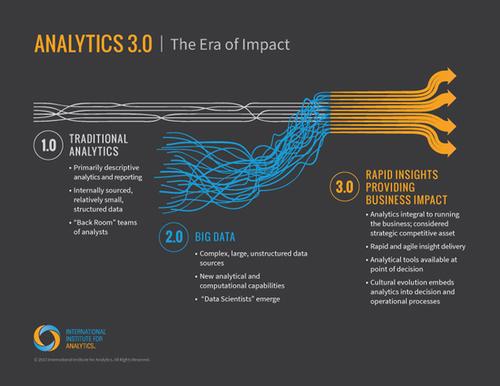When it was published in 2007, Competing Analytics: The New Science of Winning sparked the imagination of many business leaders. It opened eyes to the concept of analytics as a strategic capability, beyond basic reporting, financial analysis, and basic marketing optimization. The authors Thomas Davenport and Jeanne Harris established themselves as leading thinkers in an emerging field. However, the book found its critics among some analytics professionals (like us) who felt it delivered a superficial understanding of the real challenges “on the ground” and offered guidance that was abstract, academic, and anecdotal.
At the time, we said his advice for becoming an analytics competitor was "a good example of condensed misperceptions about what analytics can and should do."
Others were less circumspect:
- The top review on Amazon states: “This is the glib, anecdotal book built around a basic, almost stereotypic Harvard Business Review five-level model, this one focusing on various levels of use of analytical methods, systems and processes.”
- From Neil Raden: "what Davenport is implying is not only centralized control, but also centralized design. This is another naive assumption, because many organizations are not only decentralized—they’re dysfunctional."
Even with mixed feedback, it was clear that Competing on Analytics hit a nerve. Davenport and Harris continued their research and evaluation of the analytics world, and in my opinion, have made progress in reflecting the realities and challenges of analytics practitioners. In 2010, they released a book entitled Analytics at Work that focused more on the front-line realities of information workers. In December 2013, Davenport and Harris published an article in the Harvard Business Review entitled Analytics 3.0.
With this evolution, I feel they have begun to capture the essence of the analytics opportunity ahead. In particular, they have begun to focus on how data can be used to enhance product offerings — shifting the focus from smarter internal decisions to smarter, higher-value product offerings. In their conversations with data savvy companies, they describe seeing "a new resolve to apply powerful data-gathering and analysis methods not just to a company’s operations but also to its offerings—to embed data smartness into the products and services customers buy."
They go on to say:
Today it’s not just information firms and online companies that can create products and services from analyses of data. It’s every firm in every industry. If your company makes things, moves things, consumes things, or works with customers, you have increasing amounts of data on those activities. Every device, shipment, and consumer leaves a trail. You have the ability to analyze those sets of data for the benefit of customers and markets. You also have the ability to embed analytics and optimization into every business decision made at the front lines of your operations.
In the HBR article, Davenport and Harris describe what it takes for companies to engage in Analytics 3.0, and include some of the standard messages that we’ve become so accustomed to from the era of Big Data: more data, more “data management options" (i.e. Hadoop, NoSQL, in-memory, etc.), faster technologies and faster analysis. Perhaps least compelling for me is a concept of creating "analytics on an industrial scale.” Apparently IBM has created a data model factory and assembly line to make and maintain 5,000 models a year. It isn’t clear whether this kind of approach would be appropriate or useful for most other companies.
However, when they delve into the human and organization challenges, their message is more resonant with our experience. For example, they highlight the need for:
- Focus on delivering analytics to the front-line decision makers. These are the people who are making everyday decisions that impact customers. The best analytical solutions do a good job of presenting data that helps people within their current workflow in ways that are easy to understand and act upon.
- Time and resources need to be invested into data discovery to understand data before delivering analytical products. Too often we see analytics and reporting rushed out to an audience without a clear sense of what metrics matter and what information will actually help the recipient.
- Collaboration must occur between the business, analysts, and IT. This is certainly one of those concepts that is easier said than done. Nevertheless, it is better to recognize this challenge up front than believe a cohort of elite data scientists will be able to bring analytics to the masses.
- Top-level leadership needs to support the deep embedding of analytics into products and services. While this is true, we have also found that achieving successes at a grassroots level can help convince leadership of the opportunity in analytical products.
- Prescriptive analytics (the effort to use data to specify optimal behaviors and actions) will be more valuable than descriptive analytics and more common than predictive analytics. We’ve found that the analytics needs to have a clear and strong point of view to guide users to insights and actions.
- Organizations need to focus on transforming how decisions are made. Davenport and Harris state: "Managers need to become comfortable with data-driven experimentation. They should demand that any important initiative be preceded by small-scale but systematic experimentation.” The challenge is in building a culture of data fluency — something we tackle in our upcoming book.
Every day we talk with companies that view their data as an asset that can help them either 1) augment and enhance their existing solutions; or 2) generate new revenue streams. Like Davenport and Harris, we feel these are the early days. Some companies still view customer reporting as an unfortunate requirement rather than an opportunity to build loyalty. Other companies haven’t had the time or resources to find ways to make their products more powerful with data. That understanding will come. Gartner predicts that 30% of businesses will be monetizing their data by 2016 and McKinsey Consulting is seeing similar evidence that companies are finding ways to turn data into dollars. We are excited to have a front-row seat.

